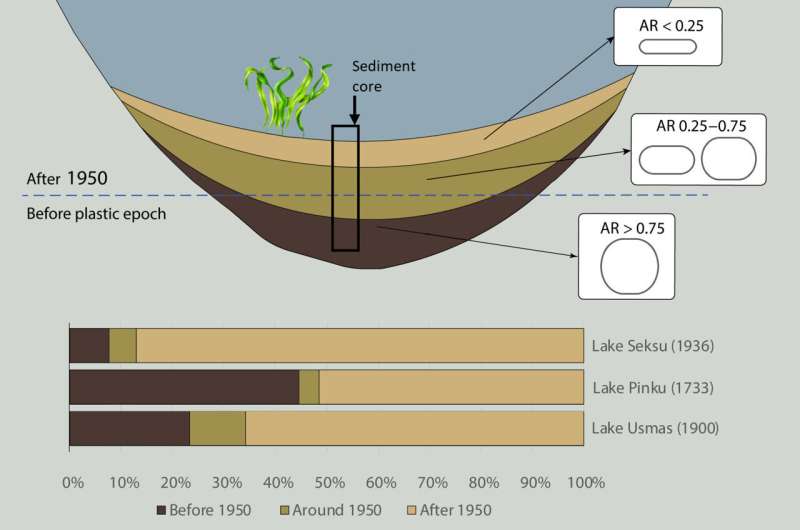Lake bottom testing shows plastics migrating down into sediment layers
A team of environmentalists, geographers and ecologists affiliated with several institutions in Europe has found that microplastics have migrated into multiple sediment layers in three lakes in Latvia. In their study, published in the journal Science Advances, the group drilled core samples from three lakes in Latvia and analyzed their contents for microplastics.
Research over the past few years has shown that microplastics have become pervasive around the planet, from soil where food is grown, to rivers, lakes and streams—and even the clouds. Prior research has also suggested that the Earth has entered a new geological age, moving from the Holocene Epoch to the Anthropocene, a change that most in the Earth science community believe began in the 1950s.
Most also agree that the transition is the result of human impact. And because plastics have been tied to so many of the changes that have occurred, some suggest using its presence as a barometer to measure the start of the Anthropocene. In this new study, the research team working in Latvia has found that doing so many not be feasible.
The work involved collecting core sediment samples from the bottom of three lakes in Latvia. Each of the samples was then analyzed to measure amounts of plastic. At the outset, the researchers assumed that sample portions preceding the creation and use of plastics would be zero. Unfortunately, that was not the case.
The researchers found plastics in sediment that had been deposited as far back as the early 1700s, a finding that indicates that plastics can migrate through sediment down to lower layers. This finding prevents the use of plastics as a barometer for the onset of the Anthropocene.
The researchers also note that because there are so many factors involved, including the type of soil that makes up sediment, material in the water and its temperature, and the many types of plastics found, studying their source would prove to be exceedingly challenging.
More information:
Inta Dimante-Deimantovica et al, Downward migrating microplastics in lake sediments are a tricky indicator for the onset of the Anthropocene, Science Advances (2024). DOI: 10.1126/sciadv.adi8136
© 2024 Science X Network
Citation:
Lake bottom testing shows plastics migrating down into sediment layers (2024, February 27)
retrieved 27 February 2024
from https://phys.org/news/2024-02-lake-bottom-plastics-migrating-sediment.html
This document is subject to copyright. Apart from any fair dealing for the purpose of private study or research, no
part may be reproduced without the written permission. The content is provided for information purposes only.

A team of environmentalists, geographers and ecologists affiliated with several institutions in Europe has found that microplastics have migrated into multiple sediment layers in three lakes in Latvia. In their study, published in the journal Science Advances, the group drilled core samples from three lakes in Latvia and analyzed their contents for microplastics.
Research over the past few years has shown that microplastics have become pervasive around the planet, from soil where food is grown, to rivers, lakes and streams—and even the clouds. Prior research has also suggested that the Earth has entered a new geological age, moving from the Holocene Epoch to the Anthropocene, a change that most in the Earth science community believe began in the 1950s.
Most also agree that the transition is the result of human impact. And because plastics have been tied to so many of the changes that have occurred, some suggest using its presence as a barometer to measure the start of the Anthropocene. In this new study, the research team working in Latvia has found that doing so many not be feasible.
The work involved collecting core sediment samples from the bottom of three lakes in Latvia. Each of the samples was then analyzed to measure amounts of plastic. At the outset, the researchers assumed that sample portions preceding the creation and use of plastics would be zero. Unfortunately, that was not the case.
The researchers found plastics in sediment that had been deposited as far back as the early 1700s, a finding that indicates that plastics can migrate through sediment down to lower layers. This finding prevents the use of plastics as a barometer for the onset of the Anthropocene.
The researchers also note that because there are so many factors involved, including the type of soil that makes up sediment, material in the water and its temperature, and the many types of plastics found, studying their source would prove to be exceedingly challenging.
More information:
Inta Dimante-Deimantovica et al, Downward migrating microplastics in lake sediments are a tricky indicator for the onset of the Anthropocene, Science Advances (2024). DOI: 10.1126/sciadv.adi8136
© 2024 Science X Network
Citation:
Lake bottom testing shows plastics migrating down into sediment layers (2024, February 27)
retrieved 27 February 2024
from https://phys.org/news/2024-02-lake-bottom-plastics-migrating-sediment.html
This document is subject to copyright. Apart from any fair dealing for the purpose of private study or research, no
part may be reproduced without the written permission. The content is provided for information purposes only.
